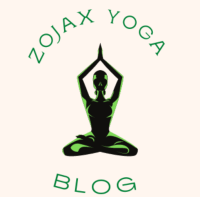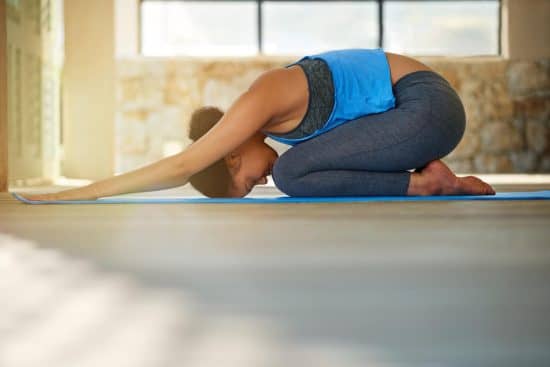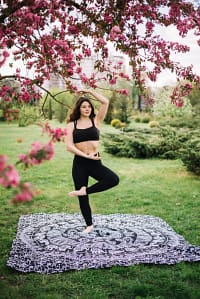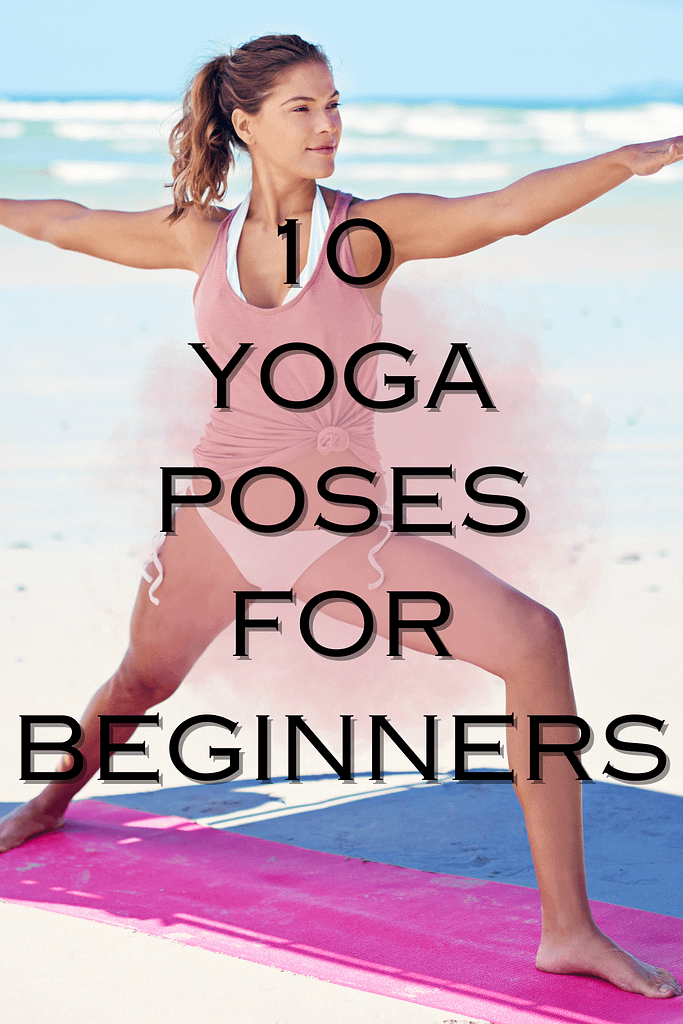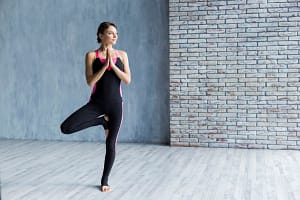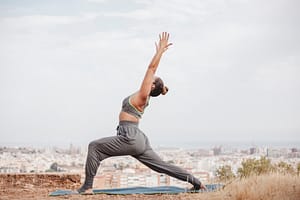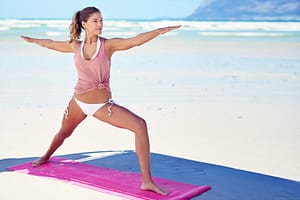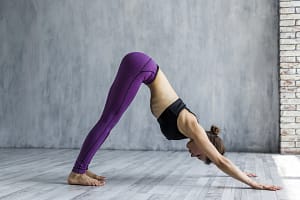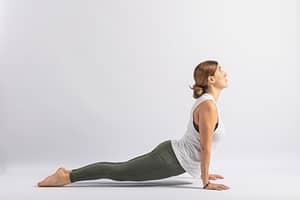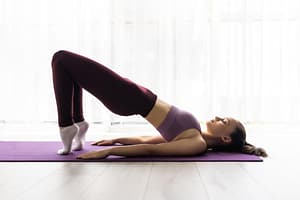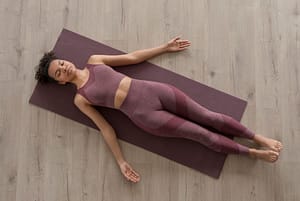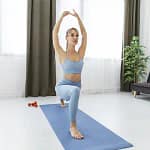key takeaways
- Beginner-friendly yoga poses include Mountain Pose (Tadasana), Downward-Facing Dog (Adho Mukha Svanasana), Child’s Pose (Balasana), and Corpse Pose (Savasana).
- Starting yoga requires focusing on basic poses, proper alignment, and breathing techniques.
- Consistency is crucial for developing a successful yoga practice.
- With these yoga poses for beginners, you can improve flexibility, strength, mental clarity, and stress reduction.
- The article provides detailed instructions for 10 essential yoga poses for beginners.
How should a beginner start yoga?
For someone new to yoga, starting a practice can seem intimidating. However, with the right guidance and approach, beginners can ease into their yoga journey with confidence. It is important to begin with basic yoga poses that focus on building a strong foundation and improving flexibility. Some beginner-friendly yoga poses that are commonly recommended include tadasana (mountain pose), adho mukha svanasana (downward-facing dog), and savasana (corpse pose).
Given the benefits of yoga for health, everyone can practice it, including youngsters, the elderly, those who are extremely fat, and those with a variety of medical conditions.
⇒ Note: 6 Basic Yoga Poses for Beginners
When practicing these yoga poses, beginners should pay attention to their posture and alignment to prevent injury. They can start by inhaling and exhaling deeply while holding each pose, focusing on strengthening their upper body, lower back, and thighs. It is essential to listen to their bodies and not push themselves too hard or too quickly.
Using a yoga mat can provide comfort and stability while practicing. Beginners can also benefit from seeking guidance from a yoga teacher or yoga instructor who can help them with proper alignment and technique. Over time, beginners can gradually straighten their wrists and feet together in poses like tadasana and forward bend for a deeper stretch.
Overall, starting with a few easy yoga poses and gradually incorporating more challenging yoga asanas can help beginners build strength, flexibility, and relieve stress effectively. Consistency in practicing yoga and finding a yoga routine that works for them will set beginners on a path to success in their yoga practice.
Design by Freepik
Yoga practice is a great way to improve flexibility, strength, and mental clarity. Starting with simple yoga poses for beginners is a good way to ease into the practice and gradually build up your skills. Some beginner yoga poses include Mountain Pose, Downward Dog, and Child’s Pose.
As you progress in your practice, you can begin to incorporate more advanced poses and sequences, such as the Warrior Series, Triangle Pose, and Tree Pose. Remember to focus on your breathing and listen to your body’s limits, pushing yourself gently into each stretch but never to the point of pain.
Creating a yoga flow by linking poses together in a sequence can help to improve your strength and flexibility even further.
⇒ Note: Incorporating Yoga into Your Life: 9 Reasons to Embrace this Transformative Practice
Flowing from one pose to the next with smooth transitions can also help to calm the mind and reduce stress.
So, whether you are just starting out with beginner yoga or have been practicing for years, incorporating stretches for flexibility and a consistent yoga flow into your routine will help to keep your body and mind healthy and balanced.
Perhaps the biggest problem is how to start. If you’ve ever watched people practicing yoga and thought you’d love to learn their skill, this is your chance to give it a try.
Top 10 yoga poses for beginners
Top 10 yoga poses for beginners include basic poses such as child’s pose, downward dog, and seated forward fold. These simple yoga poses are great for those new to beginner yoga to start their practice yoga journey. Seated forward fold involves bending your knees and reaching your hands towards the floor to stretch the entire body. Downward dog requires you to lift your knees off the ground and straighten your legs, while keeping your head down and spreading your fingers on the mat. Child’s pose is a resting pose that can help reduce stress and back pain.
⇒ Note: Sun Salutation Health Benefits
You can choose different types of yoga, like vinyasa yoga, restorative yoga, and also yoga poses that refer to different parts of the body, such as yoga for core strength and also for mental health, like yoga for relaxation and stress relief and yoga for energy. You can also incorporate mindfulness meditation into your yoga practice.
1. How to do Mountain Pose (Tadasana)
To perform Mountain Pose (Tadasana), stand with your feet together, grounding your weight evenly through the soles. Engage your leg muscles while keeping your knees slightly bent. Lift your chest, roll your shoulders back, and let your arms hang naturally at your sides.
Inhale deeply, reaching your arms overhead with palms facing each other, and lengthen your spine. Hold the pose for a few breaths, focusing on your balance and centering your mind.
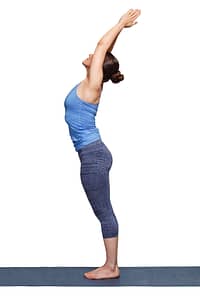 Design by Freepik
Design by Freepik
2. How to do Tree Pose (Vrksasana)
To begin Tree Pose (Vrksasana), stand tall with your feet together, grounding yourself evenly. Shift your weight onto your left foot, bending your right knee and placing your right foot on your left thigh or calf, avoiding the knee.
Bring your palms together at your heart center or stretch your arms overhead with palms facing each other. Focus on a point in front of you to maintain balance and hold the pose for several breaths.
To release, gently lower your right foot and return to the starting position. Repeat on the opposite side.
Design by Freepik
3. How to do Warrior I (Virabhadrasana I)
To perform Warrior I (Virabhadrasana I), begin by standing tall with your feet together. Step your left foot back about three to four feet, keeping your right knee bent over the right ankle.
As you ground your back heel into the mat, raise your arms overhead, palms facing each other or touching. Ensure your torso is facing forward and engage your core for stability.
Hold the pose for several breaths, feeling the strength and energy of Warrior I before transitioning to the next posture.
Design by Freepik
4.How to do Warrior II (Virabhadrasana II)
To perform Warrior II (Virabhadrasana II), begin by standing tall with your feet together. Step your left foot back about three to four feet, keeping your right knee bent directly over your right ankle.
Extend your arms parallel to the floor, palms facing down, and gaze over your right fingertips. Ensure your shoulders are relaxed and your back leg is straight, engaging your core for stability.
Hold the pose for several breaths, feeling the strength and grounding it offers, before switching sides.
Design by Freepik
5. How to do Downward-Facing Dog (Adho Mukha Svanasana)
To practice Downward-Facing Dog (Adho Mukha Svanasana), begin on your hands and knees in a tabletop position. Spread your fingers wide and tuck your toes under. As you exhale, lift your hips up and back, straightening your legs and form an inverted V shape. Keep your spine long and your heels pressing towards the ground. Focus on your breath and hold the pose for several deep breaths, feeling the stretch in your hamstrings and calves.
Ensure your head is between your arms, with your ears aligned with your upper arms. Engage your core to maintain stability while relaxing your neck. You can pedal your feet gently to deepen the stretch in your legs. Hold Downward-Facing Dog for 5-10 breaths before slowly returning to the starting position. This pose not only stretches the entire body but also helps calm the mind.
Design by Freepik
6. How to do Upward-Facing Dog (Urdhva Mukha Svanasana)
To perform Upward-Facing Dog (Urdhva Mukha Svanasana), start by lying flat on your stomach with your legs extended and the tops of your feet pressing into the mat. Place your hands under your shoulders, elbows close to your body. Inhale as you press into your hands, lifting your chest and thighs off the ground. Keep your shoulders down and away from your ears, opening your heart towards the sky.
Engage your core and avoid collapsing your lower back. Hold the pose for several breaths, feeling the stretch in your spine and chest. To exit, exhale as you lower back down, returning to your starting position. This pose strengthens the back and improves posture while enhancing flexibility.
Design by Freepik
7. How to do Seated Forward Fold ( Paschimottanasana )
To perform the Seated Forward Fold (Paschimottanasana), begin by sitting on the floor with your legs extended straight in front of you. Flex your feet and engage your thighs. Inhale, lengthening your spine, and as you exhale, hinge at your hips, reaching forward toward your feet.
Keep your back as straight as possible and avoid rounding your spine. If you can, grasp your feet or shins. Hold the pose for several breaths, feeling the stretch along your hamstrings and back.
With each exhale, deepen the fold while maintaining a relaxed neck and shoulders. Focus on your breath, allowing it to guide your movement and enhance your relaxation.
Design by Freepik
8. How to do Bridge Pose (Setubandhasana)
To perform Bridge Pose (Setubandhasana), start by lying on your back with your knees bent and feet flat on the floor, hip-width apart. Press your feet into the ground as you lift your hips toward the ceiling, engaging your core and thighs. Clasp your hands under your back, or keep your arms at your sides, depending on your comfort level. Hold the pose for several breaths, allowing your chest to open and shoulders to relax.
To deepen the stretch, you can place a block under your sacrum for support. Ensure your knees stay aligned over your ankles, avoiding any splaying. Focus on breathing steadily, feeling the expansion in your chest and the grounding sensation in your feet. To release, gently lower your hips back to the mat and unwind, enjoying the benefits of this restorative pose.
Design by Freepik
9. How to do Child Pose ( Balasna )
To perform Child Pose (Balasana), begin by kneeling on the floor, ensuring your big toes touch while your knees are apart. Sit back on your heels and extend your arms forward, resting your forehead on the mat. This position allows for deep relaxation and a gentle stretch for the back.
Focus on your breath, inhaling deeply through the nose and exhaling through the mouth. Hold the pose for several breaths, allowing your body to soften and release tension.
To exit the pose, gently lift your head, tuck your arms in, and slowly rise back to a seated position. Child Pose is an excellent way to calm the mind and rejuvenate the spirit.
Design by Freepik
10. How to do Savasana (Corpse Pose)
To practice Savasana (Corpse Pose), begin by lying flat on your back, ensuring your body is aligned. Spread your arms and legs comfortably apart, allowing your palms to face upward. Close your eyes and take deep, calming breaths, focusing on releasing tension from each part of your body.
As you settle into the pose, let your mind drift away from distractions. Stay in Savasana for 5 to 15 minutes, allowing yourself to absorb the benefits of relaxation. To exit, gently wiggle your fingers and toes, then slowly roll to one side before rising.
Design by Freepik
Can a beginner do yoga everyday?
Yes, a beginner can absolutely practice yoga every day! Starting a daily yoga routine can improve your flexibility and strength, both physically and mentally.
Even short sessions can bring amazing benefits, helping to build mindfulness and reduce stress. Remember, it’s about listening to your body and progressing at your own pace.
Say yes to this journey; each session is a step towards a healthier, more balanced you!
What is the best time for yoga?
The best time for yoga practice is when you can fully commit your energy and focus. Many find that practicing yoga in the morning sets a positive tone for the day, improving body and mind health. However, evening yoga practice also offer a chance to unwind and reflect, making it essential to choose a time that resonates with your lifestyle and goals.
⇒ Note: Here are 50 Must-know BEGINNER YOGA POSES with Yoga by Uliana
